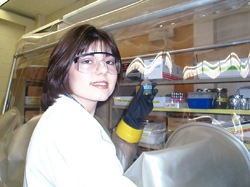Fuel Oxygenates (MTBE, TBA, and Ethanol)
Introduction
Fuel oxygenate compounds, such as methyl tertiary butyl ether (MTBE), tertiary butyl alcohol (TBA), and ethanol, are added to gasoline to improve combustion, which results in improved air quality. But there are questions about the behavior of gasoline if it should enter groundwater:
Benzene, another gasoline constituent, is usually the most hazardous compound in groundwater at a fuel spill site. But what is the effect of ethanol and MTBE in a fuel spill on the natural biodegradation of benzene? Monitored natural attenuation—when natural processes act to reduce contamination in the context of a controlled site cleanup—is often not an appropriate approach to cleanup, and state agencies must implement active cleanup. But how well conventional technology works for treating MTBE is not fully known. Additional research is being done by EPA scientists on how well conventional remediation technologies work for treating MTBE fuel spills. ProductsMTBEUS EPA. (2005) "Monitored Natural Attenuation of MTBE as a Risk Management Option at Leaking Underground Storage Tank Sites." Publication No. EPA/600/R-04/179. | Abstract Wilson, J.T., R. Kolhatkar, T. Kuder, P. Philp, and S.J. Daugherty. (2005). “Stable Isotope Analysis of MTBE to Evaluate the Source of TBA in Ground Water.” Ground Water Monitoring and Remediation, 25, 4: 108–116. Hattan, G., B. Wilson, and J.T. Wilson. (2003). “Performance of Conventional Remedial Technology for Treatment of MTBE and Benzene at UST Sites in Kansas.” Remediation, 14, 1: 85–94. Wilson, B.H. and J.T. Wilson. (2003). “Remedial Costs for MTBE in Soil and Ground Water.” In: MTBE Remediation Handbook. Edited by E. Moyer and P. Kostecki. Amherst Scientific Publishers. p. 349-360. Wilson, J.T. (2003). “Aerobic In Situ Bioremediation.” In: MTBE Remediation Handbook. Edited by E. Moyer and P. Kostecki. Amherst Scientific Publishers. p. 243–260. Wilson, J.T. (2003). “Fate and Transport of MTBE and Other Gasoline Oxygenates.” In: MTBE Remediation Handbook. Edited by E. Moyer and P. Kostecki. Amherst Scientific Publishers. p. 19–61. Kolhatkar, R., T. Kuder, P. Philp, J. Allen, and J.T. Wilson. (2002). “Use of Compound-Specific Stable Carbon Isotope Analyses to Demonstrate Anaerobic Biodegradation of MTBE in Ground Water at Gasoline Release Site.” Environmental Science and Technology, 26, 24: 5139–5146. Wilson, B.H. and J.T. Wilson. (2002). “Remedial Costs for MTBE in Soil and Ground Water.” Contaminated Soil Sediment and Water, July/August: 47–51. Wilson, J.T. and R. Kolhatkar. (2002). “Role of Natural Attenuation in the Life Cycle of MTBE Plumes.” Journal of Environmental Engineering, 128, 9: 876–882. US EPA. (2000) "Natural Attenuation of MTBE in the Subsurface Under Methanogenic Conditions." Publication No. EPA/600/R-00/006. TBAUS EPA. (2007) "Monitored Natural Attenuation of Tertiary Butyl Alcohol (TBA) in Ground Water at Gasoline Spill Sites." Publication No. EPA/600/R-07/100. | Abstract Wilson, J.T., R. Kolhatkar, T. Kuder, P. Philp, S.J. Daugherty. (2005). “Stable Isotope Analysis of MTBE to Evaluate the Source of TBA in Ground Water.” Ground Water Monitoring and Remediation, 25, 4: 108–116. EthanolMackay, D., N. de Sieyes, M. Einarson, K. Feris, A. Pappas, I. Wood, L. Jacobson, L. Justice, M. Noske, J. Wilson, C. Adair, and K. Scow. (2007). “Impact of Ethanol on the Natural Attenuation of MTBE in a Normally Sulfate-Reducing Aquifer.” Environmental Science and Technology, 41, 6: 2015–2021. Mackay, D.M., N.R. de Sieyes, M.D. Einarson, K.P. Feris, A.A. Pappas, I.A. Wood, L. Jacobson, L.G. Justice, M.N. Noske, K.M. Scow, and J.T. Wilson. (2006). “Impact of Ethanol on the Natural Attenuation of Benzene, Toluene, and o-Xylene in a Normally Sulfate- Reducing Aquifer.” Environmental Science and Technology, 40, 19: 6123–6130. Computer Application ContactJohn Wilson Cherri Adair
You will need Adobe Reader to view some of the files on this page. |
![[logo] US EPA](../gif/logo_epaseal.gif)
